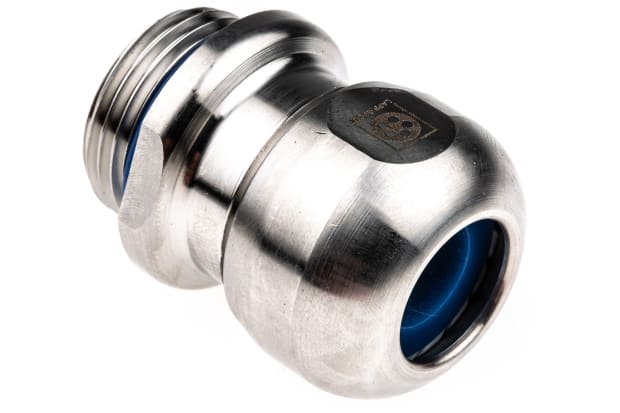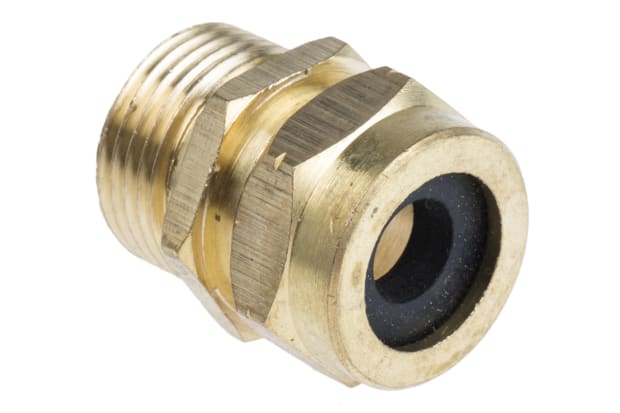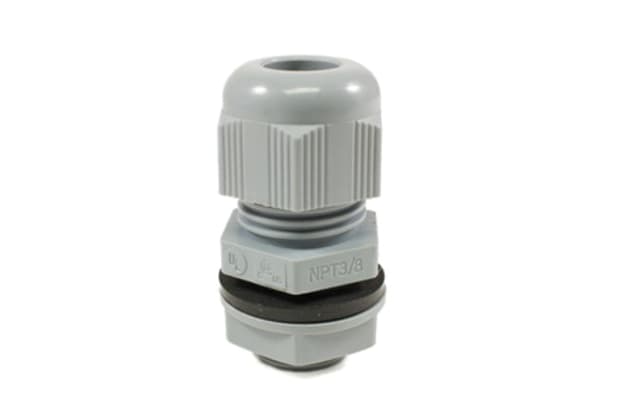- Published Mar 9, 2023
- Last Modified Jul 23, 2024
- 8 min
The Ultimate Guide to Understanding Cable Glands

What are Cable Glands?
Cable glands, also known as mechanical cable entry devices, cable connectors, cable fittings, or cord grips, are essential components used to securely terminate and seal the ends of cables. These connectors play a crucial role in ensuring the integrity and safety of electrical systems by providing robust protection against various environmental factors.
Key Functions and Benefits of Cable Glands
Cable glands are critical components in electrical systems, providing essential protection and stability to cables in various environments. They serve multiple functions, from sealing and securing cables to protecting against corrosion and preventing the ingress of flammable gases.
Below are the key functions and benefits of cable glands, which can help ensure the longevity and reliability of your electrical installations:
Seal and Secure: Cable glands effectively seal the ends of cables, preventing the entry of moisture, dust, dirt, and other contaminants that could compromise electrical connections. This sealing capability is crucial for maintaining the integrity of the electrical system, especially in challenging environments.
Protect Against Corrosion: By shielding sensitive electrical wiring from corrosive elements, cable glands help extend the lifespan of cables and maintain reliable performance. This protection is particularly important in industrial settings where exposure to harsh chemicals and environmental conditions is common.
Prevent Flammable Gas Ingress: In hazardous environments, cable glands can prevent the ingress of flammable gases, thereby reducing the risk of explosions or fires. This safety feature is vital for ensuring the protection of both equipment and personnel.
Ensure Mechanical Stability: Cable glands provide mechanical support and strain relief, ensuring that cables remain securely connected to plugs, terminals, enclosures, or other electrical equipment. This stability helps prevent accidental disconnections and reduces the risk of damage to the cables.
How Do Cable Glands Work?
Cable glands function by combining a central enclosure or body through which cables pass with several attachments that provide sealing, securing, and protection. These components typically include:
- Lock (or Check) Nut: Secures the gland to the enclosure.
- Washers: Provide additional sealing and support.
- Seal: Ensures an airtight and watertight seal around the cable.
- Attachment Claw or Cone: Grips the cable to prevent movement.
- Sealing (or Compression) Nut: Tightens to compress the seal and secure the cable.
Some advanced models may also feature two-part enclosures, tags for electrical earthing, PVC shrouding for insulation, or neoprene (rubber) sealing for enhanced protection.
Principal Functions of Cable Glands
Cable glands serve several critical functions, including:
- Fixing Cables in Place: They securely hold cables, preventing them from being twisted or accidentally pulled out.
- Providing an Airtight Seal: Cable glands keep out dust, dirt, water, and moisture, which is essential for protecting electrical equipment.
- Fortifying Against Strain: They provide strain relief, reducing the risk of cable damage due to tension or movement.
- Protecting Cable Ends: Cable glands shield the vulnerable ends of cables from damage and environmental exposure.
- Earthing Electrical Cables: Some cable glands help to earth cables, reducing the risk of electrical shocks and electrocution.
Materials Used in Cable Glands
Cable glands are made from a variety of materials, each selected for specific properties and applications:
- PVC (Polyvinyl Chloride): A flexible, non-reactive plastic ideal for general-purpose use.
- PTFE (Polytetrafluoroethylene): Highly resistant to chemicals and suitable for harsh environments.
- Nylon: A tough, multipurpose material with strong resistance to pressure and wear.
- Metals (Steel, Aluminum, Brass): Provide excellent durability and are often used in industrial applications.
- Synthetic Rubbers: Offer flexibility and resistance to environmental factors.
Browse Our Selection of Cable Glands
Nylon Cable Glands
Click here to view our collection of nylon cable glands and shop online today with RS Philippines.
Steel Cable Glands
Shop steel cable glands online, including top-quality products from leading brands.
Brass Cable Glands
Explore our full range of brass cable glands and choose the best product for your requirements.
Rubber Cable Glands
Choose from a wide range of rubber cable glands, including products in a variety of brands and sizes.
Types of Cable Glands
Cable glands come in a variety of types, each designed for specific applications and environmental conditions. Understanding the different types of cable glands is crucial when selecting the right one for your project. Here are the main types of cable glands and their key features:
Single Compression Cable Glands
Single compression cable glands are typically used in buildings and smaller installations. They feature a single sealing mechanism and are available in various types, including:
- Light-duty: Suitable for general-purpose applications with lenient sealing requirements, often used in indoor settings or low-risk areas.
- Weatherproof: Designed to provide a tight seal, protecting against moisture and environmental factors. They are commonly used in outdoor applications or areas with exposure to water.
- Flameproof or Explosion-proof: Specially constructed to prevent the spread of explosions in hazardous locations. These glands have specialized designs to keep any sparks or flames inside the enclosure, reducing the risk of electrical equipment explosions.
Double Compression Cable Glands
Double compression cable glands are primarily used in industrial settings, such as factories and power plants, where stronger seals are required. These glands feature dual sealing mechanisms, providing enhanced protection and reliability. Double compression cable glands are available in various types, similar to single compression glands, including light-duty, weatherproof, and flameproof options.
Armored Cable Glands
Armored cable glands are designed for use with steel-wire armored (SWA) cables, which are commonly used for underground and wall cabling installations. These glands provide a secure connection and protect the cable from damage caused by the steel wire armor.
Waterproof Cable Glands
Waterproof cable glands typically offer an IP68 rating, indicating their ability to withstand immersion in water at depths of one meter or more. These glands are essential for protecting cables in wet or submerged environments, ensuring a watertight seal at the cable entry point.
Metal Cable Glands
Metal cable glands are available in various materials, each offering unique benefits:
- Stainless Steel: Provides excellent corrosion and pressure resistance, making it suitable for harsh environments.
- Aluminum: Offers flexibility, resistance to rust, and good heat and electrical conductivity.
- Brass: A popular choice for its strength, resistance to magnetism and deformation, and good electrical conductivity. Brass cable glands are widely used in construction and industrial settings.
How to Install a Cable Gland
Cable glands vary but the fundamentals of installation are as follows.
Before you begin:
- Follow the manufacturer’s guidelines and ensure you comply with local codes of practice
- Switch off all electrical equipment and disconnect any live wires
- Be careful not to damage loose entry wires during installation
- Ensure your gland is fully compatible with the cables you plan to attach it to
- Make sure your cable glands are not exposed to solvents, chemical substances, or dirt during the installation process
Installation:
- Begin by opening the cable gland and detaching the nut
- Use a suitable tool to peel back the outer sheath of the cabling to a length that matches the size of the gland. Expose the inner metal armor if that is present
- Insert the right end of the gland into the cable and lay the peeled sheath or armor evenly around the gland
- Reapply the nut and carefully tighten this using a spanner or similar tool in order to secure the gland in place
Some cable glands have two halves and are designed to fit on either side of an enclosure, providing a watertight seal for a cable. Installation of these glands requires drilling a hole in the wall of the enclosure then securing each half of the gland into place.
How to Fit an Armored Cable Gland
To fit a gland to an armored or SWA cable, you will need a pair of quality wire cutters or a hacksaw, along with two suitably sized spanners.
The fitting process is as follows:
- Begin by unscrewing the cable gland and sliding the various parts onto the cable in the correct order
- Strip a length of the outer insulation as well as the inner and armoring layers and peel these back. The combination and lengths of the peeled pieces depend on the type of cable and gland you are using
- Fit the cone of the cable gland beneath the inner insulation and armoring. This may require some splaying of the core wires. Make sure these lay over the cone and do not enter it as this can cause damage to the inner insulation
- Slide up the armor gripping ring
- Screw the armor locking nut back to the cone, thereby forcing the armor gripping ring up the cone and trapping the wires in place
- Use your spanners to tighten each gland part
- Seal the back of the gland by applying the sealing nut. These compress the internal sealing against the outer insulation, making the gland watertight
Popular Cable Gland Brands
Click on the buttons below to view cable glands produced by some of our most popular brands:
Related links
- Sprocket Essentials: From Basics to Advanced Tips
- Electric Motor Maintenance Tips to Ensure Its Longevity
- Understanding PID Temperature Controllers and Their Uses
- Expert Guide to Choosing Tap Washers
- Understanding Epoxy Resin and Its Uses
- A Complete Guide to Industrial Electrical Safety
- A Complete Guide to Gate Valves
- RS PRO Black Nylon Cable Gland 30mm Min IP68






